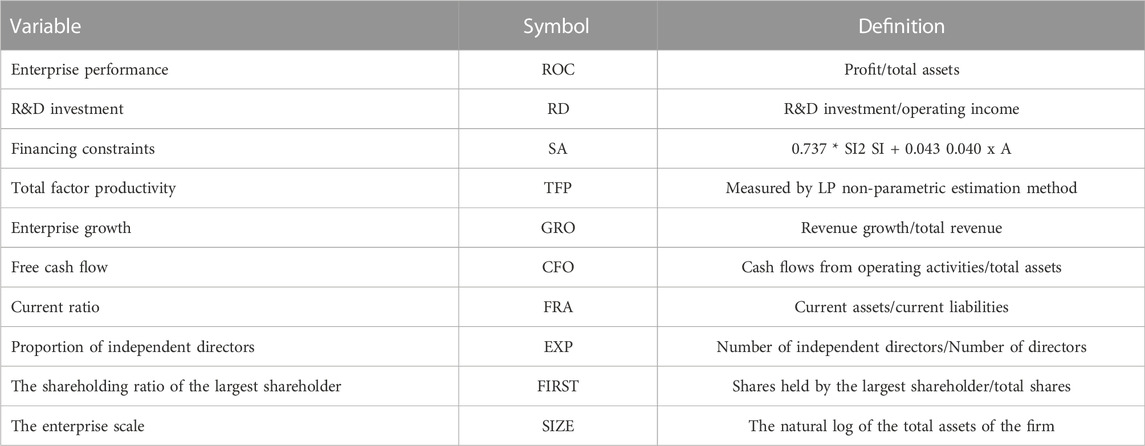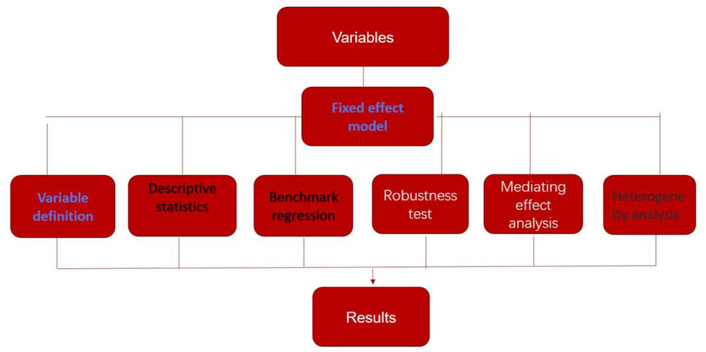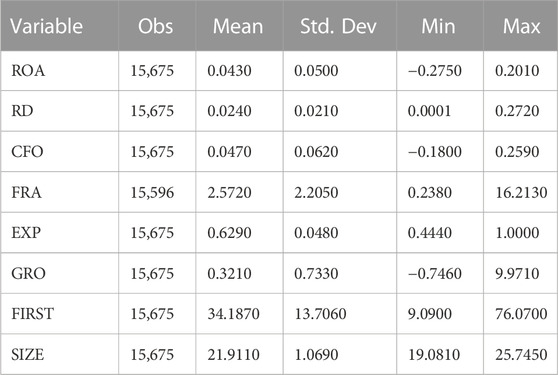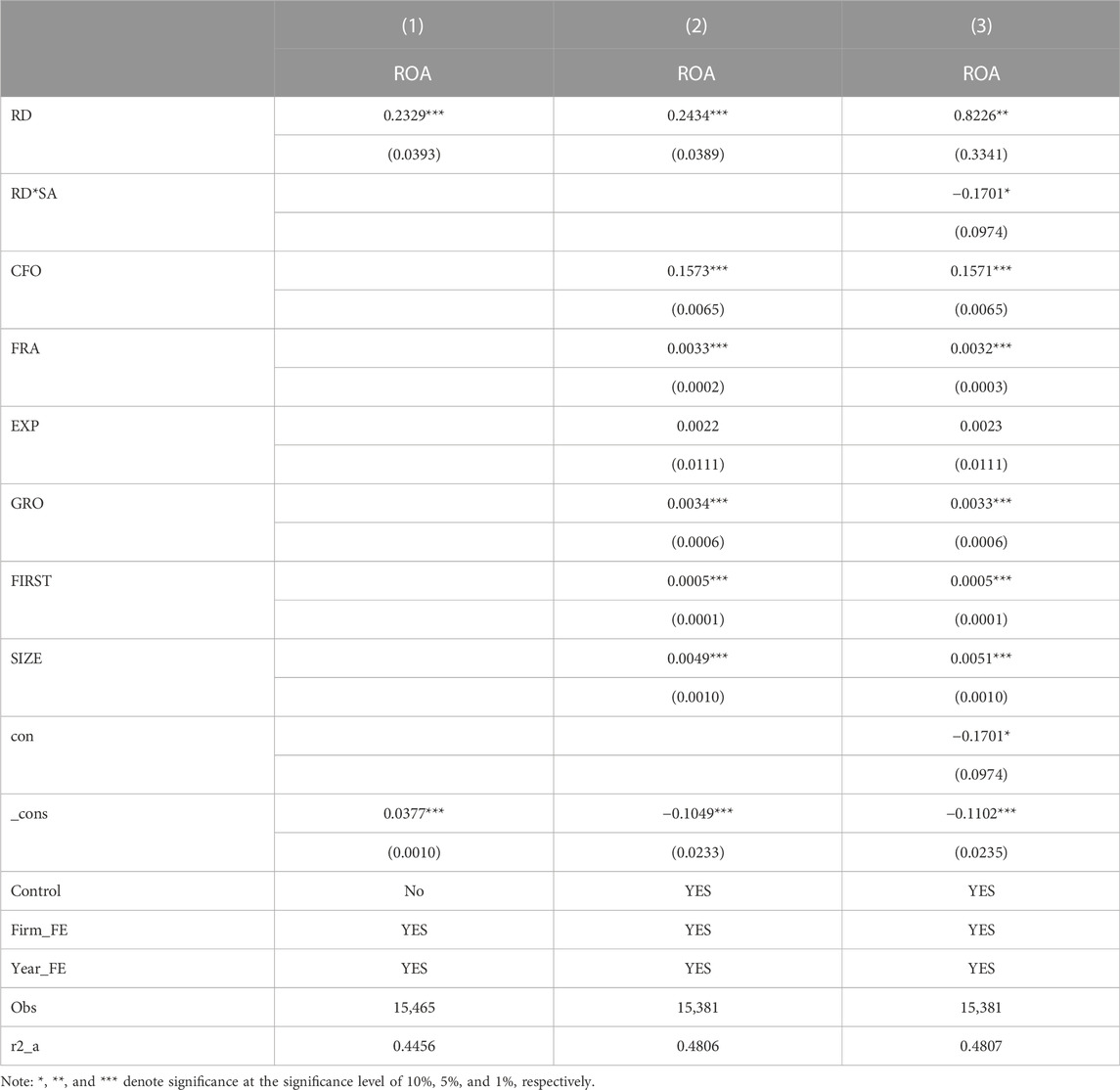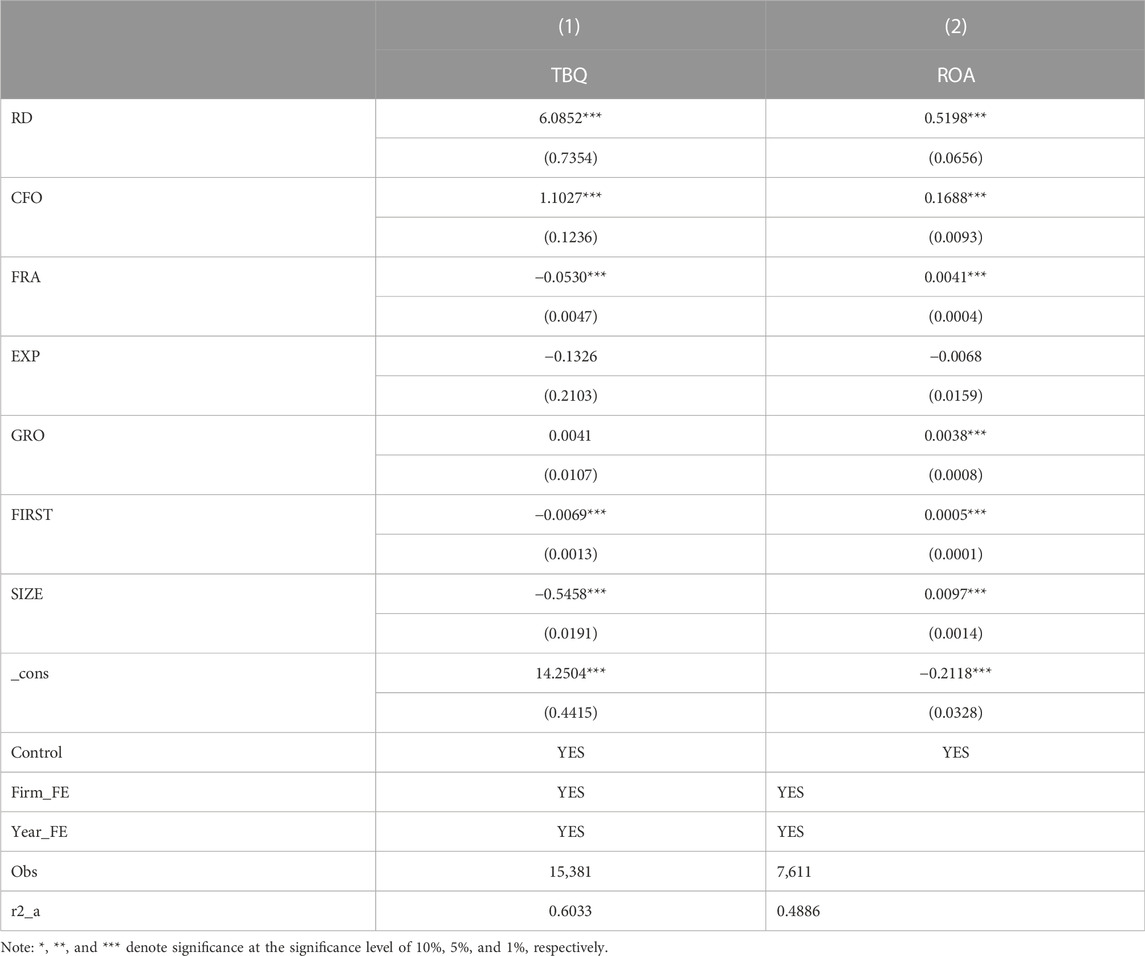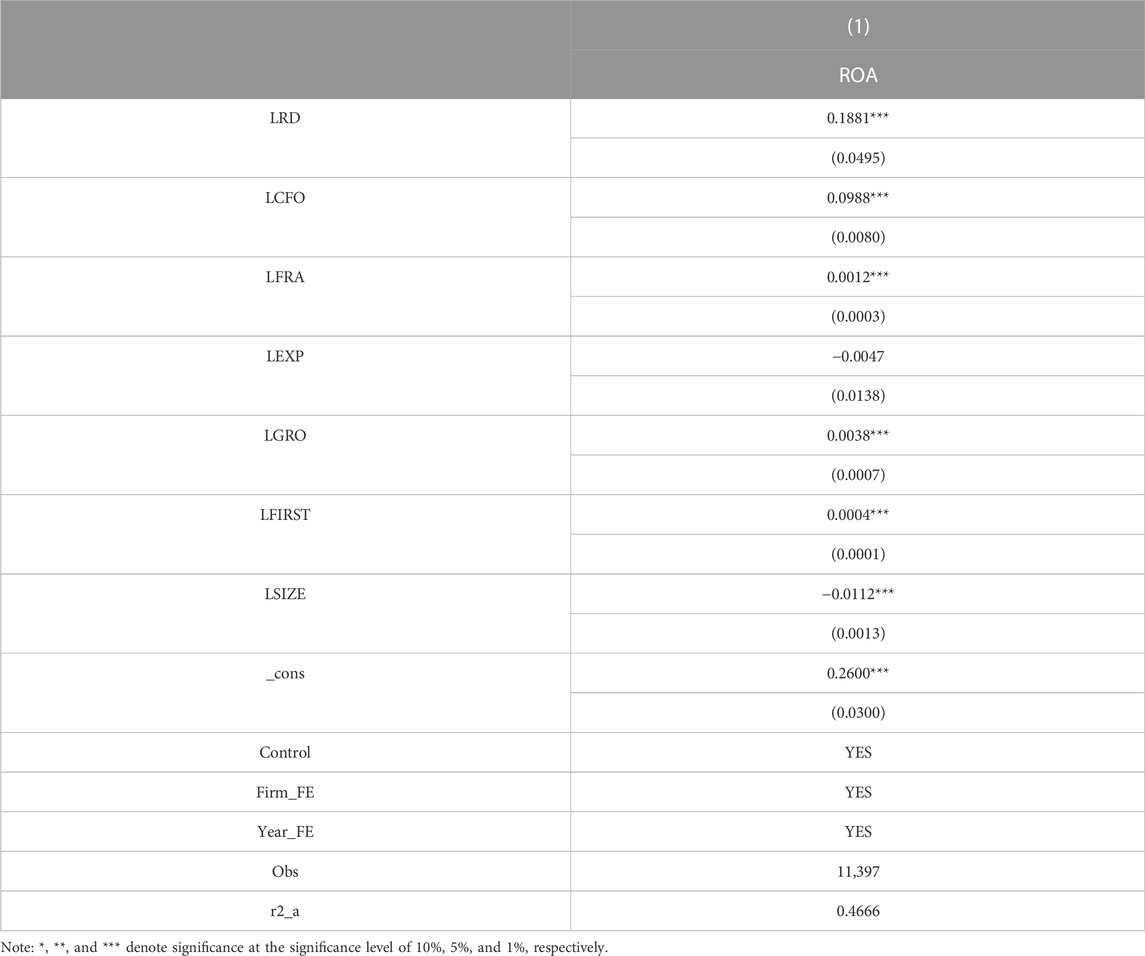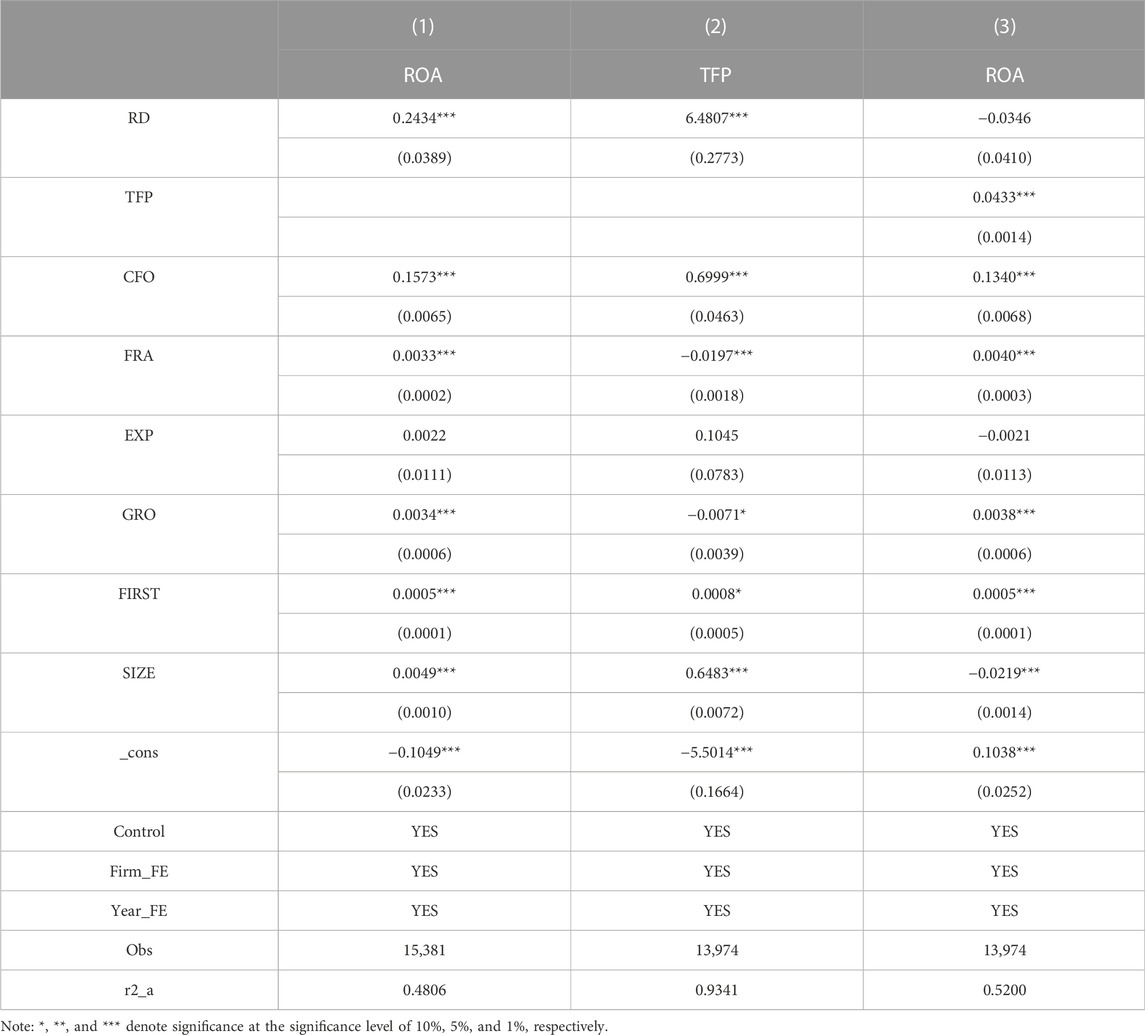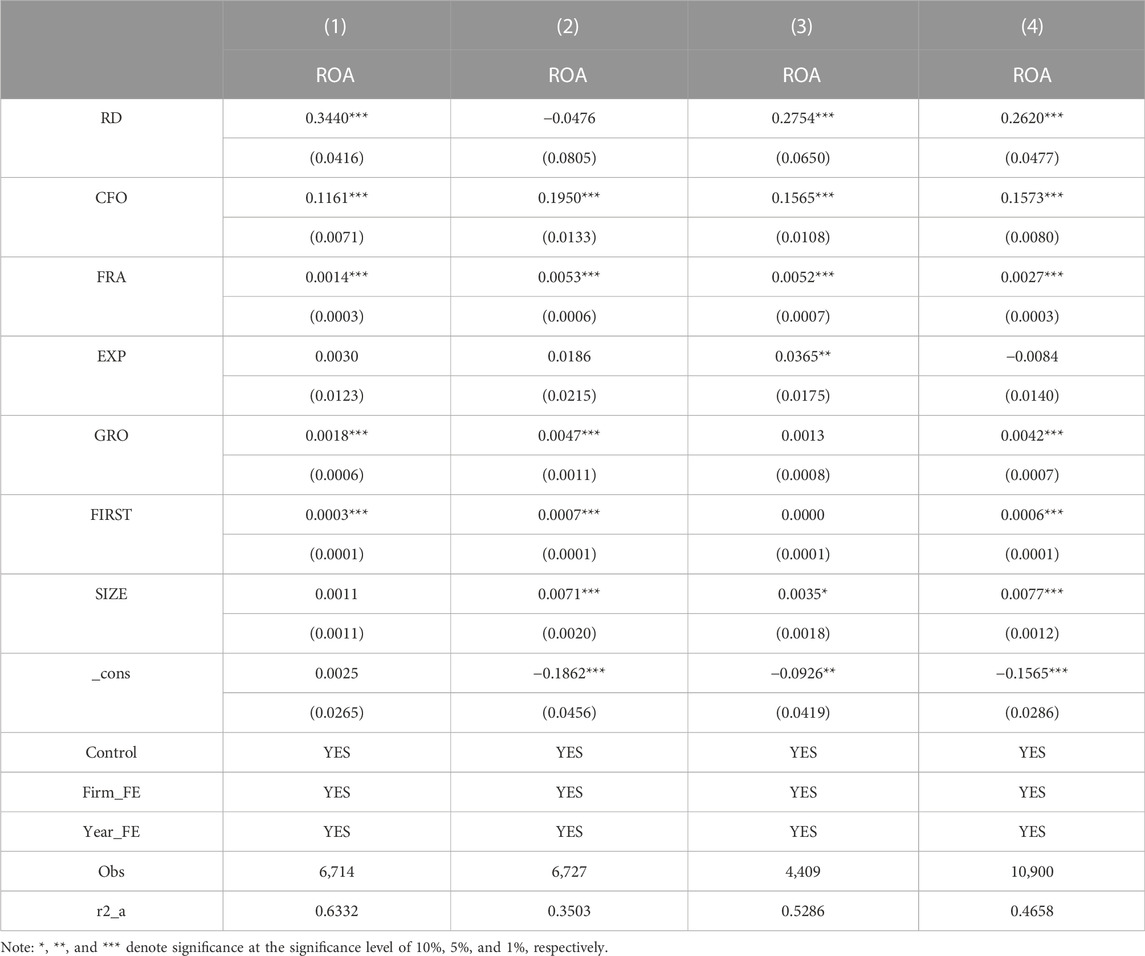- 1Lanzhou University, Lanzhou, China
- 2Dhurakij Pundit University, Lak Si, Thailand
- 3Universiti Putra Malaysia, Seri Kembangan, Malaysia
Enterprises are a deeply significant pillar of social and economic development. The excellent economic interests of enterprises play an essential role in promoting social and economic development. Business is a major innovation force in improving a country’s independent innovation capacity, which in turn is a key factor in shaping its core competitiveness. As the fuel of technological innovation for enterprises, Research and development (R&D) can accelerate their development and enhance their competitiveness. By using Chinese A-share listed companies from 2007 to 2019 as a sample, this study attempts to examine the specific impact of R&D investment by Chinese companies on corporate performance. Key to the development of R&D activities, R&D investment is directly related to the source of funding, the quality of financing channels and the extent of financing restrictions. The current study explains why enterprise innovation cannot be separated from the input and support of capital, technology, professional talent and other factors from the perspective of enterprise financing constraints. By using Chinese A-share listed companies from 2007 to 2019 as a sample, the study not only examined the impact of R&D investment on corporate performance, but also considered specific mediating mechanisms and heterogeneity analysis of R&D investment on corporate performance. Finally, the study found a significant positive correlation between R&D investment and the performance of listed companies, and this positive correlation was more pronounced when funding constraints were lower. According to the study, mediation effect analysis shows that R&D investment can improve corporate performance by boosting total factor productivity. Additional research has also shown that higher levels of internal control quality can improve the boosting effect of R&D investment on corporate performance. Moreover, R&D investment by SOEs is more conducive to improving the performance of their enterprises than that of non-SOE enterprises. In addition, this study provides empirical evidence of the knowledge effect and positive externality of R&D investment for firms, examines the impact of R&D investment on corporate performance from the perspective of financing constraints, and enriches the related literature on R&D investment, financing constraints and corporate performance.
1 Introduction
How to improve the performance of a business has long been a hot topic in the academic community. Numerous studies and practices show that corporate performance is affected by a number of factors, such as the industry environment and the company’s internal operations. To maintain strong profitability, companies must improve their competitiveness. In an increasingly competitive environment in the capital markets, the innovation and R&D of a company has become a fundamental guarantee to maintain its competitive edge and an effective way to seek the current economic growth point. Thanks to its unrivalled advantages, R&D activities have played an extremely significant role in China’s path to become a world power in science and technology. Currently, as most Chinese enterprises have recognized the crucial role of R&D investment and adopted aggressive innovation strategies. Their R&D investment intensity has become one of the highest in the world. The 2021 National science and technology funding investment communique released by the National Bureau of Statistics of China shows that in 2021, China’s total investment in R&D funds is 2,795.63 billion yuan with a year-on-year increase of 14.6%, and the growth rate is 4.4%, higher than that of the previous year. Although there have been numerous studies in the academic community on the impact of innovation input on corporate performance, no consistent conclusions have been reached. Therefore, to facilitate related research progress, we explore the impact of R&D investment on corporate performance and further investigate the moderating effect of financing constraints.
Previous studies have shown that basic research investment can significantly improve productivity under the premise of constant R&D expenditure (Mansfield, 1980). R&D expenditures are one of the most important competitive factors that bring about technological improvements, design and implementation efficiencies, and improved products and services (Rahman and Howlader, 2022). There is intense competition within an industry, especially one based on technology, due to the growth of research and development in the market. The extremely competitive market pushes companies to seek growth opportunities and large market shares to compete with competitors through different innovation strategies and original products (Ehie and Olibe, 2010). According to some scholars, while R&D investment can improve a company’s core competitiveness, it has inherent characteristics such as elevated levels of risk, strong uncertainty and prolonged R&D cycles. At the same time, R&D investment also requires the support of large amounts of capital. Funding constraints at the current stage of China’s emerging capital market are relatively high due to the fact that numerous enterprises cannot afford to make frequent R&D investments and focus only on short-term corporate performance. Therefore, relatively cautious innovation strategies have been adopted to avoid uncertainties and risks encountered in R&D and innovation (Song, 2022).
In order to explore the essential factors that drive corporate performance improvement, previous studies have explored the relationship between R&D investment and corporate performance, but no consistent conclusions have been reached. With the same motivation, and to provide some inspiration for companies to make reasonable R&D investments, this study empirically tests the impact of R&D investment on corporate performance. While previous studies have investigated the impact of R&D investment on firm total factor productivity and financing constraints on corporate performance, they have not integrated the impact of R&D investment on corporate performance. Based on this study, we believe that R&D investment can further improve corporate performance by boosting total factor productivity, and that the impact of R&D investment on corporate performance is more pronounced in companies with lower financing constraints. Motivated by this, from the perspective of corporate innovation, we investigate the impact of R&D investment on corporate performance using a fixed-effects model. At the same time, the paper discusses whether there are new changes in the impact of R&D investment on corporate performance under financing constraints, in order to provide a theoretical and practical basis for corporate management to make reasonable R&D investments. The innovative points and implications of this study are mainly as follows. First, it investigates the impact of R&D investment on corporate performance and empirically tests the mechanisms by which R&D investment promotes corporate performance by influencing the total factor productivity of the business, which can enrich related research. Second, it explores whether financing constraints can play a moderating role in the impact of R&D investment on corporate performance. Third, from an internal control perspective, it also explores whether differences in internal control quality modify the impact of R&D investment on corporate performance, thus providing evidence to support companies in further promoting internal control quality.
2 Theoretical background and hypotheses development
2.1 R&D investment and corporate performance
Corporate R&D is a long process. The benefits of research and development (R&D) have been the focus of research by scholars since Schumpeter formulated the theory of innovation. Numerous studies have shown a significant positive correlation between R&D investment and corporate performance. R&D investment plays a positive role that cannot be ignored in improving product technology and quality, and meeting consumer demand (Chen and Hu, 2020). Enterprise innovation investment not only improves the core competitiveness of enterprises, but also significantly increases their productivity. At the same time, it brings new products or processes to companies that differentiate themselves, helping to increase their market share and generate excess earnings. Theoretically, by creating new products or services through R&D activities, enterprises can temporarily make monopoly profits (Lieberman and Montgomery, 2010). In fact, while strong profits from any current product may be short-lived, relatively strong corporate profits may be sustained if firms are able to launch new products, technologies or services through continuous research and development (Benlu et al., 2020). Internal R&D investment can improve the company’s ability to utilize external technical knowledge and transform it into innovation, so it is conducive to improve the innovation performance of enterprises after technology merger and acquisition (Song et al., 2005). The empirical study of 272 enterprises in 35 industries conducted by Artz et al. (2010) shows that continuous introduction of new products can provide support for enterprises to achieve long-term high-level performance. According to the theory of innovation, innovation is the driving force in the development of a business, and technological research and development is the main factor in determining the uniqueness of a business. Many of the world’s leading companies have particularly strong R&D capabilities. For enterprises, R&D investment can be used to improve the production technology, achieve product differentiation, broaden the market boundary, form core competitiveness, and increase the market share of enterprises, so as to gain a firm foothold in the market and promote the improvement of corporate performance (Zheng and Kun, 2021). By continuously developing new technologies and products, or revamping old ones, the production efficiency and market recognition of products can be improved, and the profitability of enterprises can be considerably enhanced, which enables enterprises to have more funds to invest in research and development, forming a virtuous circle of sustainable development. Therefore, while the impact of R&D investment on corporate performance can be volatile, overall, R&D investment can drive corporate performance improvement.
Research and development can be channeled into corporate productivity, which drives the total factor productivity of the company. According to endogenous growth theory, the only way for companies to make technological progress is to increase their total factor productivity, and R&D investment is the main vehicle for technological innovation. The increase in R&D investment can be used to introduce additional modern equipment, improve production capacity and production management methods, optimize the efficiency of resource allocation, make advanced production factors flow among different departments, and improve the total factor productivity of enterprises, thus improving corporate performance (Ren et al., 2022). Qiu and Wei (2016) found that the level of total factor productivity would be significantly improved under the high intensity of R&D investment, and R&D investment can undoubtedly improve the performance of enterprises. Therefore, we believe that R&D investment can boost the total factor productivity of enterprises and subsequently improve their performance.
In summary, we propose to research hypotheses H1 and H2:
2.2 The moderating effect of financing constraints on the relationship between R&D investment and corporate performance
Different types of R&D investments involve different risks and benefits. How to make decisions when faced with the choice of R&D investment projects and schedules is an essential financial issue for enterprises. In addition to technical feasibility, companies need to consider cost-effectiveness in terms of performance and financial controllability. At the same time, the most critical financial problem in R&D investment, namely financing constraints, has become the main factor restricting the improvement of enterprise performance (Chen and Hu, 2020). In mandate relationship, where the fundamental rights and interests of the parties are different, information asymmetries can lead to moral hazard problems. Different levels of financing constraints may lead to agent conflicts of varying degrees within the enterprise, which can then have differentiated effects on R&D performance. As Chinese enterprises commonly have financing constraints of different intensity, it is necessary to incorporate financing constraints into the analysis system of the relationship between R&D investment and corporate performance. Myers and Majluf (1984) gave the definition of financing constraint, which is essentially the difference between the internal and external financing costs of an enterprise. The financing channels for enterprises mainly include internal financing and external financing. Internal financing is mainly based on the internal surplus of an enterprise itself, while external financing mainly raises funds from financial institutions, individuals or institutional investors (Du and Li, 2022). A large body of research has consistently pointed out that financing constraints largely have a restraining effect on internal R&D investment, thereby reducing the impact of R&D on corporate performance. As an in-house R&D investment, the impact on the firm’s performance is bound to be different under different funding constraints. The more constraints a company has on its R&D funds, the more focus is placed on the efficiency with which the funds can be used and the performance of the company, and the decision to spend on R&D investments will inevitably be more cautious. When financing constraints exist, enterprises will reduce the investments of R&D, thus inhibiting the improvement of innovation performance (Chen and Hu, 2020). Enterprises with high financing constraints may have R&D projects with broad development prospects, but due to risk and information asymmetry, R&D activities are stagnated, and innovation cannot be carried out (Ren et al., 2022). The development of China’s capital market started late, the financial market is not perfect, the financing channels are relatively narrow, and most enterprises are faced with different degrees of financing constraints (Chen et al., 2015). Ju (2013) pointed out that the rapid increase of innovation investment of Chinese enterprises mainly benefits from internal funds, while external financing channels play a limited role, so financing constraints have a critical impact on R&D investment and performance of enterprises. Thus, in China, financing constraints will modify the impact of R&D investment on corporate performance.
In addition to inhibiting increased R&D investment, financing constraints are also detrimental to total factor productivity and corporate performance. When the financing constraints of enterprises are lower, enterprises will get more internal capital accumulation, and enhance the risk tolerance, so that enterprises can have more funds to expand reproduction, promote enterprises to actively carry out technological upgrading and other innovative activities, so as to improve the total factor productivity and performance of enterprises. With the improvement of financing constraints, the profitability of enterprises can be improved, and positive signals can be transmitted to external investors, thus attracting social funds into enterprises, and providing impetus for enterprises to expand investment reproduction, to form scale effect and improve corporate performance (Du and Li, 2022). From the perspective of improving productivity, Guo (2017) used mathematical models to explain the impact mechanism of heterogeneous R&D investment on enterprise productivity under financing constraints. His study pointed out that the imbalance in the proportion of heterogeneous R&D investment due to financing constraints had a negative impact on the productivity growth of enterprises.
In summary, we have proposed the research hypothesis H3:
3 Research design
3.1 Sample selection and data sources
Modern accounting rules were adopted for listed Chinese companies in 2007. In late 2019, the Chinese economy began to suffer the effects of COVID-19. To avoid the impact of accounting changes and COVID-19 on the economy, the time period of our study sample was chosen to be 2007 to 2019. As only listed companies are required to provide some relevant financial statements and information, and SMEs rarely invest in R&D, we selected A-share non-financial listed companies in mainland China as our study subjects. Data for non-financial listed A-share companies in China were screened based on existing studies as follows. First, missing observations for the main study variables were removed. Second, the financial sector sample was removed. Third, companies with no R&D practices and incomplete data on major financial indicators were eliminated. Fourth, the observed values of listed companies whose shares are in an anomalous trading state, such as suspended listing, are removed. Fifth, continuous variables are reduced to control the effect of extreme values. We end up with 15, 675 sample observations. Data was collected from the CSMRA database and processed using STATA 17.0.
3.2 Variable selection
3.2.1 Dependent variable
Referring to the research of Zhang et al. (2021), we adopt return on assets (ROA) as the measurement index of enterprise performance. The higher the return on assets, the better the enterprise performance.
3.2.2 Independent variable
Referring to the research of Chen and Lu (2011), the ratio of R&D investment to operating revenue is used to measure the intensity of R&D investment (RD) of enterprises and expressed in the form of percentage. The higher the percentage, the higher the R&D investment.
3.2.3 Moderating variable
Referring to the research of Ju (2013), SA index is adopted as the measurement index of financing constraint (SA). Where, SA = −0.737 × SI + 0.043 × SI2-0.040 × A, SI is the natural logarithm of the total assets of the enterprise, A is the listed years of the enterprise, and SA is negative. By taking the absolute value of SA, the larger the absolute value, the larger the financing constraint.
3.2.4 Mediating variable
We choose to measure enterprise total factor productivity (TFP) by LP non-parametric estimation method proposed in 2003.
3.2.5 Control variables
According to relevant literature (Hu and Liang, 2017; Chen and Gong, 2020; Yao et al., 2020), we selected company-level factors such as enterprise growth (GRO), free cash flow (CFO), current ratio (FRA), proportion of independent directors (EXP), shareholding ratio of the largest shareholder (FIRST) and enterprise SIZE (SIZE) as the control variables of the main regression model to eliminate the influence of heterogeneity factors on enterprise performance.
The variables selected are shown in Table 1.
3.3 Model construction
Drawing on previous studies, considering that company and year factors may affect the regression results, we construct the following Eq. 1 to test the relationship between R&D investment and corporate performance.
In Eq. 1, the subscript i is enterprise, t is year. The dependent variable ROA is enterprise performance, the independent variable RD is enterprise R&D investment, and X represents control variables.
In order to test the moderating effect of financing constraints on R&D investment and enterprise performance, on the basis of Eq. 1, the multiplication term (RD*SA) of RD and SA index is added, and the dependent variable and control variables are the same as above. The specific model is as follows:
To further empirically test the mediating effect of TFP between R&D investment and corporate performance, we establish the following mediating effect model:
In Eqs 3, 4, TFP is mediating variable total factor productivity. If
The study will follow the following tools (see Figure 1), focusing on the methodological approach. We used the econometric software Stata 17.0 for our empirical analysis. The Stata commands used in this study include sum, asdoc, reghdfe, and bootstrap.
4 Empirical results
4.1 Descriptive statistics
Table 2 lists the descriptive statistical results for the main variables. The mean value of enterprise performance (ROA) is 0.0430, and the standard deviation is 0.0500. The average value of R&D investment (RD) is 0.0240, the maximum value is 0.2720, and the minimum value is 0.0001, indicating that the R&D investment intensity of Chinese enterprises is relatively modest on the whole, and there is still a large room for improvement.
4.2 Benchmark regression
Table 3 shows the benchmark regression results for the impact of R&D investment on corporate performance. Column (1) shows the results without adding control variables when control enterprises’ fixed effects and year fixed effects, and the coefficient of RD is 0.2329, which is significant at the 1% level. Column (2) further adds control variables, and the coefficient of RD is 0.2434, which is significant at 1% level. The results show that the coefficient of RD is significantly positive in columns (1) and (2), indicating that higher R&D investment can improve the performance level of China’s A-share listed companies. Therefore, hypothesis H1 has been verified.
Column (3) of Table 3 lists the results of the impact of R&D investment level on corporate performance after considering financing constraint as a moderating variable. The results show that the coefficient of the interaction term between R&D investment and financing constraint (RD*SA) is -0.1701, which is significant at 10% level. This indicates that serious financing constraints will inhibit the promoting effect of R&D investment on corporate performance. That is, financing constraints show a negative inhibitory effect on the impact of R&D investment on corporate performance. Hypothesis 3 is verified.
4.3 Robustness checks
4.3.1 Replace the dependent variable
Referring to the research of Zhu and Zhang (2013), we use the market value index Tobin Q (TBQ) to measure enterprise performance. (Tobin Q= (market value of tradable shares + number of non-tradable shares × net asset value per share + book value of liabilities)/total assets) The regression results are shown in column 1) of Table 4. The coefficient of RD is 6.0852, which is significant at the level of 1%, indicating that R&D investment can effectively promote corporate performance, in line with previous conclusions.
4.3.2 Eliminate the sample of provincial capitals.
The capital of China is the political, economic, scientific, educational, cultural and transportation center of the national first-level administrative region (generally a province). To avoid certain biases due to the special political status of provincial capitals, we excluded enterprises in provincial capitals and performed regression again. The regression results are shown in column (2) of Table 4. The coefficient of RD is 0.5198, which is significant at the 1% level. After excluding the sample of enterprises in provincial capitals, R&D investment can still significantly contribute to the improvement of business performance, which is consistent with the previous conclusions.
4.3.3 Lag the explanatory variable with the control variable by one period
Considering that there may be a time lag effect in the promotion effect of R&D investment growth on corporate performance, we regressed the independent variable and control variables in Eq. 1 after one period lag. The regression results are shown in Table 5. The LRD coefficient is 0.1881, which is significant at the 1% level. This suggests that this conclusion still holds after accounting for the possible lag effect of R&D investment on corporate performance.
5 Further analysis
5.1 Mediating effect analysis
Theoretical analysis shows that increased investment in R&D can boost business performance. Moreover, R&D investment can improve corporate performance by boosting total factor productivity. In the following, we analyze the mediation effect. R&D and innovation play an essential role in increasing the total factor productivity of enterprises, and can further boost their performance. According to the three-step method of the mediating effect model, we regression Eqs 1, 3, 4 respectively, to test whether the mediating effect of total factor productivity (TFP) of enterprises is significant. Columns (1) to (3) of Table 6 show the regression results of R&D investment on corporate performance, R&D investment on total factor productivity, and R&D investment and total factor productivity on corporate performance. It can be seen that R&D investment has a significantly positive effect on the total factor productivity of the enterprise, with a coefficient of 0.0433 for TFP, which is significantly positive at the 1% level, but not significant for RD when both are used to perform regression of the firm’s performance. This suggests that the mediator effect is more pronounced than the direct effect.
In order to further confirm the mediating effect, the Bootstrap test was conducted on Eq. 4 in Table 6 by referring to the research of Wen and Ye (2014), and the test results are shown in Table 7 below. In Table 7, bs1 represents indirect effect and bs2 represents direct effect. It can be found that the model that passes the Bootstrap test and the mediator effect is significantly established. This suggests that R&D investment can indeed improve corporate performance by boosting total factor productivity.
5.2 whether differences in internal control quality alter the impact of R&D investment on corporate performance
Internal control is essential for enterprises to achieve strategic objectives of critical management tools. A healthy internal control system has a significant impact on R&D investment and corporate performance. On the one hand, it can improve the strain capacity of an enterprise in the presence of environmental uncertainties.; on the other hand, it can also consolidate the owner to supervise the management, positive signals to outside investors (Yan and Yang, 2022), and enhance the financing ability. By referring to the research of Zeng et al. (2022), we take the internal control index in Internal Control and Risk Management Database as the indicator to measure the quality of internal control (DIB). The higher the value of this index, the higher the quality of internal control. We then consider firms with an internal control index greater than the industry median as firms with strong internal control quality, and firms with an internal control index less than the industry median as firms with low internal control quality, and perform group regression. The regression results are shown in columns (1) and (2) of Table 8. The coefficient of influence of R&D investment on corporate performance is 0.3440, which is significant at the 1% level for companies with better quality internal controls. The coefficient of influence of R&D investment on business performance is −0.0476, but this is not significant for businesses with low internal control quality. The development of a business will be affected by the internal environment of the business. When the quality of internal control is higher, the role of R&D investment will naturally be promoted and its impact on the performance of the company will be enhanced, which is conducive to the development of the company.
5.3 Whether the difference in firm nature changes the impact of R&D investment on corporate performance
The nature of a business is an essential factor in its development. Differences in business objectives and risk control between SOEs and non-SOEs will have an impact on business activities. Therefore, it is necessary to distinguish the samples according to the nature of the property rights before conducting the study. We perform regression on the sample of state-owned enterprises and the sample of non-state-owned enterprises, respectively, and the regression results are shown in columns (3) and (4) of Table 8. It can be seen that the coefficient of influence of R&D investment on corporate performance is 0.2754 for SOEs and 0.2620 for non-SOEs, both of which are significant at the 1% level. This indicates that increased R&D investment by SOEs is more effective in improving corporate performance. Compared with non-state-owned enterprises, SOEs have an advantage in financing loans, with banks and other financial institutions more willing to lend money to powerful SOEs. Therefore, R&D investment by SOEs can promote the improvement of corporate performance.
6 Discussion of the results
In this section, we discuss the findings found in this empirical analysis. In the benchmark regression, we found that expanding R&D investment can significantly promote enterprise performance, which is consistent with some existing research results (Hall and Mairesse, 1995; Hsieh et al., 2003). Based on the findings, we ask the following questions: What are the possible explanations for the findings? We believe that the knowledge effect and positive externality brought by R&D investment can bring economic benefits to enterprises themselves, which has also been confirmed by some existing studies (Hall and Mairesse, 1995; Hsieh et al., 2003; Stam and Wennberg, 2009). For example, Stam and Wennberg (2009) found that research and development made it possible to utilize external knowledge, thus promoting the development of enterprises.
To show more concrete knowledge effects and positive externality brought by R&D investment, we then perform a mediation effect analysis. The results show that R&D investment boosts the total factor productivity of enterprises, which then improves their performance. The finding that R&D investment promotes TFP improvement is consistent with numerous existing literature (Wang and Li, 2017; Liu and Lin, 2021). In addition, when the resulting total factor productivity increases, the company’s performance also improves.
In our analysis of the impact of financing constraints on the relationship between R&D investment and corporate performance, we found that the lower the financing constraints, the more R&D investment can be used to boost corporate performance. We believe that financing constraints are constraining companies in every way. When financing constraints are serious, enterprises will have difficulties in R&D investment and thus hinder the improvement of total factor productivity, which is consistent with the conclusions of existing literature (Ren et al., 2022; Zhao et al., 2015).
In the heterogeneity analysis, we explore whether the difference between the level of internal control and the nature of the firm changes the impact of R&D investment on corporate performance. The results show that R&D investment has a greater impact on corporate performance when the level of internal control is higher and when the company is state-owned. According to existing literature, a higher level of internal control of enterprises represents better corporate governance and is conducive to increasing enterprise value (Tian and Chen, 2015). However, companies with defective internal control will increase the risk of falling stock market price, and face higher audit fees and systemic risks, which will affect corporate performance (Hogan and Wilkins, 2008; Dhaliwal et al., 2011). These ideas are consistent with the results of this study. For state-owned enterprises, their special status will bring numerous conveniences, such as easier access to loans, and further expand the impact of R&D investment on corporate performance, which is consistent with some existing research conclusions (Deng and Sun, 2014; Ali et al., 2019).
7 Conclusion
In the context of China’s economic transition, the development of enterprises is often considerably influenced by innovation factors such as R&D investment. The orderly development of R&D activities can help enterprises improve their technical level, continuously introduce new products with greater market competitiveness, or improve their technological processes, enabling them to reduce costs and improve production efficiency and performance. In fact, this study will shed some light on the formulation of rational R&D investments and lay the foundation for subsequent related studies.
Using Chinese A-share listed companies from 2007 to 2019 as a sample for the analysis, we empirically study the impact of R&D investment on corporate performance and the moderating effect of financing constraints. Then we draw the following conclusions. First, the higher the investment in research and development, the better the improvement in corporate performance. This conclusion still holds after robustness checks. In addition, financing constraints will significantly alter the impact of R&D investment on corporate performance. The lighter the financing constraints, the more additional R&D investment can be used to boost corporate performance. Second, according to the mediation effect analysis, R&D investment can modify corporate performance by affecting the firm’s total factor productivity. Third, R&D investment by companies with higher internal control quality are more conducive to improving their performance than those with lower internal control quality. Fourth, R&D investment by SOEs can significantly boost the performance of companies compared to non-SOEs.
As an essential means of corporate management, internal control can ensure better business activities, reduce information asymmetry, and enhance corporate trust. Therefore, improving the level of internal control of enterprises will promote better conversion of R&D investment into high-yield products and improve corporate performance. This view is supported by some literature (Wang and Li, 2015; Wang and Jiang, 2022).
8 Policy recommendations
What policy recommendations might emerge from this study? The motivation for this study is not only to explore the impact of R&D investment on corporate performance, but also to focus on the impact of financing constraints in this context. Based on the findings of the study, We propose the following. First enterprises should increase R&D investment, spend money where it counts the most, and strive for breakthroughs in core and key technologies. Second, we should strengthen the construction of government services, optimize the business environment, standardize information disclosure (alleviate the problem of information asymmetry), better meet the needs of investors and creditors, so as to reduce external financing costs and improve the financing constraints faced by enterprises. In addition, the government should increase fiscal and tax support, increase credit support, optimize financing services, and improve the financial availability of private enterprises (especially SMEs). Third, the enterprise should proceed from the characteristics of the industry, be risk-oriented, take into account the principle of cost effectiveness, strengthen the internal supervision, control and governance of the enterprise, and pay more attention to the supervision environment, critical control points, information transmission process and other essential parts.
And even though China has focused for years on solving the difficult and costly financing problem for small and medium-sized enterprises, it has not fundamentally solved the problem. In China, the venture capital threshold is relatively steep and listing is more difficult. The vast majority of SME financing still relies on creditor claims and bank loans. Bank lending, however, invariably favors strong public companies. Therefore, the shortage of loan supply for SMEs is the root cause of their financing difficulties. We believe that we should pay attention to solving the problem of information asymmetry of enterprises, improve the enthusiasm of banks in lending to tiny and medium-sized enterprises, vigorously develop and standardize the complementary role of non-bank financial institutions in the field of lending to tiny and medium-sized enterprises, give play to the “catfish” effect of non-bank financial institutions, and create competition pattern and market pressure for banks. Finally, this research topic can open up channels for policy discussions among industry, government and researchers to promote effective cultivation of corporate innovation capacity, ease financing constraints and strengthen internal controls.
9 Study recommendations and limitations
Still, the research is not without limitations. This study focuses only on the Chinese case and lacks empirical analysis of other countries. The specific coefficient of impact of R&D investment on corporate performance measured in this paper is 0.2434. However, there are a large number of listed companies in China and the situation varies from company to company, so it is difficult for companies to make specific R&D investment plans based on this figure. This study does not consider the case of unlisted Chinese companies due to difficulties in obtaining data and other issues, and is therefore of minor reference for SMEs. This study was not able to measure the specific impact of financing constraints on the relationship between R&D investment and corporate performance. Moreover, this study does not provide a more specific empirical analysis of the way R&D investment affects corporate performance. If more practical experience could be provided on the impact of R&D investment on corporate performance, it would provide additional support for the development of R&D theory and a greater understanding of the positive externality of R&D.
Advance research should consider additional countries and construct different metrics to measure R&D spending through SMEs. Researchers should construct a model that can accurately measure the impact of financing constraints on the relationship between R&D investment and corporate performance, and further explore ways to mitigate financing constraints. In addition, researchers should also consider the long-term impact of R&D investment on corporate performance.
Data availability statement
The original contributions presented in the study are included in the article/Supplementary Material, further inquiries can be directed to the corresponding authors.
Author contributions
XW: Conceptualization, methodology, formal analysis, funding acquisition and writing―original draft. MF: Methodology, writing―original draft, resources, supervision, software, writing―review and editing. YF: Software, validation, investigation, data curation, and writing―original draft. YL: Proofreading, data analysis and conclusion modification. XT: Proofreading and literature review.
Conflict of interest
The authors declare that the research was conducted in the absence of any commercial or financial relationships that could be construed as a potential conflict of interest.
Publisher’s note
All claims expressed in this article are solely those of the authors and do not necessarily represent those of their affiliated organizations, or those of the publisher, the editors and the reviewers. Any product that may be evaluated in this article, or claim that may be made by its manufacturer, is not guaranteed or endorsed by the publisher.
References
Ali, S., Zhang, J., Usman, M., Khan, F. U., Ikram, A., and Anwar, B. (2019). Sub-national institutional contingencies and corporate social responsibility performance: Evidence from China. Sustainability 11, 5478. doi:10.3390/su11195478
Artz, K., Norman, P. M., Hatfield, D. E., and Cardinal, L. B. (2010). A longitudinal study of the impact of R&D, patents, and product innovation on firm performance. J. Prod. Innovation Manag. 27 (5), 725–740. doi:10.1111/j.1540-5885.2010.00747.x
Benlu, H., Yin, X., and Jin, C. (2020). CEO Characteristics, R&D Investment and corporate performance. Res. Sci. Sci. (02), 276–287. doi:10.16192/j.cnki.1003-2053.2020.02.010
Chen, H., and Lu, D. (2011). Research on the correlation between R&D investment and firm value. Soft Sci. (2), 20–23.
Chen, J., and Hu, B. (2020). Financing constraint, heterogeneous R&D investment and corporate performance. Finance Account. Commun. (14), 69–87. doi:10.16144/j.cnki.issn1002-8072.2020.14.013
Chen, X., Xing, H., and Yun, X. (2015). Study on the efficiency of social responsibility fulfillment of listed pharmaceutical companies in China. China Pharm. 26 (13), 1743–1746.
Chen, Z., and Gong, Y. (2020). The impact of green finance on corporate performance and its mechanism. Econ. Manag. Rev. 38 (05), 72–85. doi:10.13962/j.cnki.371486/f.2022.05.006
Deng, C., and Sun, J. (2014). QFII ownership, property rights and financing constraints, Manag. World, 05, 180–181. doi:10.19744/j.cnki.11-1235/f.2014.05.018
Dhaliwal, D., Hogan, C., Trezevant, R., and Wilkins, M. (2011). Internal control disclosures, monitoring, and the cost of debt. Account. Rev. 86 (4), 1131–1156. doi:10.2308/accr-10043
Du, Q., and Li, Q. (2022). Research and development expense deduction, financing constraint and total factor productivity. Finance Theory & Pract. (08), 81–91.
Ehie, I., and Olibe, K. (2010). The effect of R&D investment on firm value: An examination of US manufacturing and service industries. Int. J. Prod. Econ. 128 (1), 127–135. doi:10.1016/j.ijpe.2010.06.005
Guo, Y. (2017). Research on the influence mechanism of heterogeneous R&D investment on firm productivity. Dalian: Dalian University of Technology.
Hall, B. H., and Mairesse, J. (1995). Exploring the relationship between R&D and productivity in French manufacturing firms. J. Econ. 65 (01), 263–293. doi:10.1016/0304-4076(94)01604-x
Hogan, C. E., and Wilkins, M. S. (2008). Evidence on the audit risk model: Do auditors increase audit fees in the presence of internal control deficiencies? Contemp. Account. Res. 25 (1), 219–242. doi:10.1506/car.25.1.9
Hsieh, P. H., Mishra, C. S., and Gobeli, D. H. (2003). The return on R&D versus capital expenditures in pharmaceutical and chemical industries. IEEE Trans. Eng. Manag. 50 (2), 141–150. doi:10.1109/tem.2003.810828
Hu, Y., and Liang, D. (2017). Corporate governance, government subsidies and corporate performance. Finance Account. Commun. (33), 70–73.
Ju, X. (2013). Financing sources and smoothing mechanism of innovation investment of Chinese listed firms. World Econ. 36 (4), 138–159. doi:10.19985/j.cnki.cassjwe.2013.04.008
Lieberman, M. B., and Montgomery, D. B. (2010). First-mover advantages. Strateg. Manag. J. 9 (S1), 41–58. doi:10.1002/smj.4250090706
Liu, Y., and Lin, C. Z. (2021). Research and development expense plus deduction policy and enterprise total factor. Stud. Sci. Sci. 10, 1790–1802. doi:10.16192/j.cnki.1003-2053.20210208.001
Mansfield, E. (1980). Basic research and productivity increase in manufacturing. Philadelphia: American Economic Review, 863–873.
Myers, S. C., and Majluf, N. S. (1984). Corporate financing and investment decisions when firms have information that investors do not Have. J. Financ. Econ. 13 (2), 187–221. doi:10.1016/0304-405x(84)90023-0
Qiu, Y., and Wei, W. (2016). The impact of R&D investment on corporate performance: A study based on propensity score matching. Contemp. Finance Econ. (3), 96–106. doi:10.13676/j.cnki.cn36-1030/f.2016.03.010
Rahman, M. M., and Howlader, M. S. (2022). The impact of research and development expenditure on firm performance and firm value: Evidence from a south asian emerging economy. J. Appl. Account. Res. 23 (4), 825–845. doi:10.1108/jaar-07-2021-0196
Ren, Y., Zhang, X., Wu, J., and He, Z. (2022). Government subsidies, R&D investment and Total factor Productivity: An empirical study of Chinese manufacturing enterprises. Sci. Decis. (07), 44–62.
Song, M., Bij, H. V. D., and Weggeman, M. (2005). Determinants of the level of knowledge application: A knowledge-based and information-processing perspective. J. Prod. Innov. Manage. 22 (5), 430–444. doi:10.1111/j.1540-5885.2005.00139.x
Song, W. (2022). Key executive compensation gap, R&D investment and enterprise performance. Finance Account. Commun. 2021 (04), 50–53.
Stam, E., and Wennberg, K. (2009). The roles of R&D in new firm growth. Small Bus. Econ. 33 (01), 77–89. doi:10.1007/s11187-009-9183-9
Tian, L., and Chen, T. (2015). Enterprise Internal control, Social responsibility and financial performance. J. Chongqing Univ. Soc. Sci. Ed. 21 (02), 75–82.
Wang, H., and Jiang, N. (2022). Internal control quality, R&D investment and corporate financial performance: An empirical study based on A-share listed medical manufacturing companies. J. Liaoning Tech. Univ. Soc. Sci. Ed. 24 (01), 28–35+75.
Wang, X. R., and Li, H. Y. (2017). The impact of R&D input from different executive departments on total factor productivity:from the perspective on China US comparison. Stud. Sci. Sci. 6, 853–862. doi:10.16192/j.cnki.1003-2053.2017.06.007
Wang, Y., and Li, J. (2015). Innovation input, internal control and performance of high-tech enterprises. Finance Account. Mon. (24), 34–37. doi:10.19641/j.cnki.42-1290/f.2015.24.006
Wen, Z., and Ye, B. (2014). Analyses of mediating effects: The development of methods and models. Adv. Psychol. Sci. 22 (05), 731–745. doi:10.3724/sp.j.1042.2014.00731
Yan, H., and Yang, H. (2022). Environmental Uncertainty, Internal Control Quality and corporate performance: Evidence from specialized equipment manufacturing industry. J. Commer. Account. 2022 (10), 25–29.
Yao, X., Yang, C., and Yao, M. (2020). Research on manager's ability and company performance based on enterprise life cycle. Xinjiang Finance Econ. (06), 35–47. doi:10.16716/j.cnki.65-1030/f.2020.06.004
Zeng, J., Liu, G., and Pang, R. (2022). CEO financial expertise, internal control and corporate performance: Empirical evidence from Chinese listed companies. Int. J. Finance (05), 87–96. doi:10.16475/j.cnki.1006-1029.2022.05.008
Zhang, M., Wang, Q., and Chu, S. (2021). Analysis on the relationship between corporate social responsibility, financing constraint and corporate performance of listed pharmaceutical companies in China. China Pharm. 32 (05), 518–523.
Zhao, C., Wen, L., and Zhao, M. (2015). The impact of financing constraints on the total factor productivity of enterprises: A study based on industrial enterprise data. Econ. Longitude Latitude 32 (03), 66–72. doi:10.15931/j.cnki.1006-1096.2015.03.012
Zheng, H., and Kun, L. (2021). Research and development investment, executive team heterogeneity and corporate performance. Finance Account. Commun. (08), 27–31. doi:10.16144/j.cnki.issn1002-8072.2021.08.003
Keywords: R&D investment, financing constraints, enterprise performance, mediating effect, internal control quality
Citation: Wang X, Fan M, Fan Y, Li Y and Tang X (2022) R&D investment, financing constraints and corporate financial performance: Empirical evidence from China. Front. Environ. Sci. 10:1056672. doi: 10.3389/fenvs.2022.1056672
Received: 29 September 2022; Accepted: 28 November 2022;
Published: 12 December 2022.
Edited by:
Mohamed Chakib Kolsi, Emirates College of Technology, United Arab EmiratesReviewed by:
Matheus Koengkan, University of Aveiro, PortugalShahid Ali, Nanjing University of Information Science and Technology, China
Copyright © 2022 Wang, Fan, Fan, Li and Tang. This is an open-access article distributed under the terms of the Creative Commons Attribution License (CC BY). The use, distribution or reproduction in other forums is permitted, provided the original author(s) and the copyright owner(s) are credited and that the original publication in this journal is cited, in accordance with accepted academic practice. No use, distribution or reproduction is permitted which does not comply with these terms.
*Correspondence: Min Fan, MTE2MDUyOTg4MUBxcS5jb20=; Yaojun Fan, eWFvanVuLmZhbkBkcHUuYWMudGg=; Yue Li, bm9sZWUzNkBnbWFpbC5jb20=; Xianghua Tang, dHhoMzk1NUBnbWFpbC5jb20=
 Xiaohong Wang1
Xiaohong Wang1 Yaojun Fan
Yaojun Fan